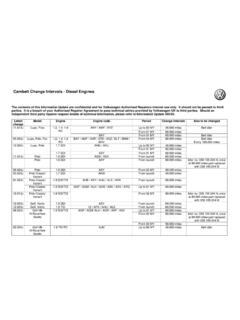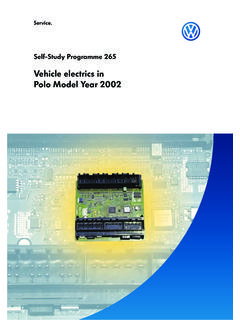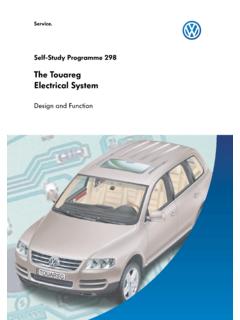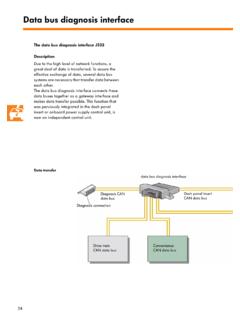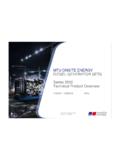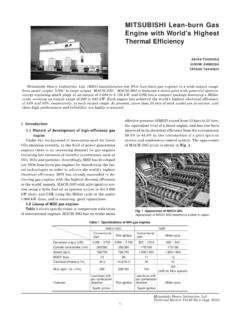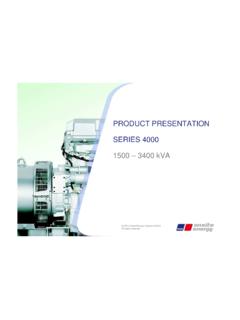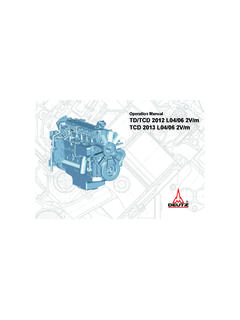Transcription of SSP330 - The diesel particulate filter system with …
1 Service TrainingSelf-study programme 330 The diesel particulate filter system with additiveDesign and Function2 Combustion will remain in the foreseeable future an important method of energy conversion, whether in power stations, cars or even fireplaces. Every fire leaves behind harmful by-products of combustion - particles of soot for example. The aim is to avoid risks to the environment and health caused by the generation and release of carbon aspects and strict emissions legislation have led engineers to place particular emphasis on the conti-nual reduction of particulate emissions. One way to reduce the emission of carbon soot is with a diesel particulate filter . S330_001 Further information on the subject of exhaust gas can be found in the following self-study programmes: SSP 124: diesel engine with catalytic converter SSP 230: Vehicle exhaust emissions SSP 315:European onboard diagnosis for diesel enginesNEWC autionNoteThe self-study programme represents the design and function of new developments!
2 The contents will not be current testing, adjustment and repair instruc-tions, refer to the relevant service .. 4 Design and function .. 12 system overview.. 19 Sensors and actuators .. 20 Functional diagram .. 31 system limits ..32 Service ..33 Test yourself.. 354 IntroductionGeneralDuring combustion of diesel fuel, all sorts of different deposits are built up. Those that can be perceived directly as emissions components on a cold engine are non or partly oxidised hydrocarbons in droplet form as white or blue smoke and strong smelling addition to harmful gaseous substances, particles of solid substances are emitted with the emissions from diesel engines, which have been included under the main heading of particulates with regards to substances that are damaging to health and the follows a long-term strategy with the aim of reducing exhaust emissions not only in the area of diesel particulates but also for all other emissions components, such as hydrocarbons and nitrogen oxides.
3 Some years ago, Volkswagen undertook tough measures on a continual basis to optimise the internal combustion processes and to reduce the emission of carbon soot particles from diesel engines. And with success: In 1999, Volkswagen was able to offer the Lupo 3L TDI on the market as the first vehicle to meet the strict Euro 4 exhaust emissions standard six years before the standard was established as a legal requirement in 2005. Volkswagen played an important role in driving on the development for clean diesel fuel and thereby faced the responsibility of protecting the environment. Examples of this are the efficient, economical and low noise generating TDI technology and also the unit injector system . Volkswagen will continue to selectively improve internal combustion processes in the future to further bring down fuel consumption and reduce emissions directly at source.
4 In addition, Volkswagen will enhance these efforts step-by-step by the introduction of diesel particulate filter exhaust gasEmissions standardsIn the Republic of Germany, across Europe and throughout the world, laws have been passed in recent years to reduce the emission of harmful substances in the air. In Europe, the emissions standards are categorised from EU1 to EU4. These prescribe emission limits to the automobile industry for type approval of new vehicle of the year 2000, EU3 is the emissions standard for new vehicle differs from its predecessor EU2 by more stringent conditions on the test bed and by a reduction in the limit EU4 standard will come into force in 2005 and will supersede EU3. The consequences are a further reduction in permissible limit values.
5 Even now, more than 65 percent of all Volkswagens with diesel engines newly registered in Germany fulfil emissions standard ,20,60,40,8g/kmHC + NOXCOPMNOXEU3EU4EU3EU4EU3EU4EU3EU40,640, 500,560,300,500,250,050,025 Carbon monoxideHydrocarbons and nitrogen oxidesNitrogen oxidesSoot particlesPermissible limit values for diesel enginesOutlookIn the future, the more stringent EU5 standard will come into force. The limit values for this standard have as yet not been established, but acceptable emission levels will be lowered even further. There are plans to markedly reduce the particulate limit value for diesel passenger vehicles even further. Therefore, all diesel passenger vehicles must be fitted with a particulate filter in the future.
6 6 IntroductionHarmful substances caused by combustionThe harmful substances, and particulate emissions in particular, are influenced in a diesel engine by the combustion process. This process is affected by many factors relating to the construction, the fuel itself and the following illustration shows an overview of the inlet and exhaust components of a diesel engine during 67%CO2H2ON2approx. 12%approx. 11%HCNOXCOO2SO2 PMapprox. 0,3%approx. 10%S330_108 Injected fuel: HCHydrocarbonsSSulphurIntake air: O2 Oxygen N2 Nitrogen H2 OWater (humidity)Exhaust gas:O2 OxygenN2 NitrogenH2 OWater CO2 Carbon dioxideCO Carbon monoxideHCHydrocarbonsSO2 Sulphur dioxideNOx Nitrogen oxidePM Carbon soot particles(PM = particulate matter) with regards to the damaging effect on the environment and health, the emissions from a diesel engine have various components that require different analyses.
7 Those components that are already present in the atmosphere (oxygen, nitrogen and water) can be categorised as dioxide, which is present in the atmosphere as a natural gas, is at the limit between safe and harmful due to its categorisation. It may not be poisonous, but in higher concentrations it can contribute towards the greenhouse effect. Carbon monoxide, hydrocarbons, sulphur dioxide, nitrogen oxide and particulates are categorised as substances in the exhaust gasS330_014CO Carbon monoxideCarbon monoxide (CO) is generated from oxygen deficiency as a result of the incomplete combustion of fuels containing carbon. It is a gas and has no colour, smell or taste. S330_016 HCHydrocarbonsHydrocarbons cover a wide range of different compounds (for example C6H6, C8H18), which occur as a result of incomplete combustion.
8 S330_018SO2 Sulphur dioxideSulphur dioxide is generated by the combustion of fuel containing sulphur. It is a gas without colour but with a pungent smell. The amount of sulphur added to fuel is decreasing. S330_020 NOxNitrogen oxidesNitrogen oxides (for example NO, NO2, ..) are generated by high pressure, high temperature and excessive oxygen during combustion in the engine. S330_022 Soot particlesIf there is an oxygen deficiency the result is a build up of carbon soot particles from incomplete combustion. 8 IntroductionThe particulatesParticulates is a term that covers all particles, solid or liquid, that are generated from friction, breakdown of components, erosion, condensation and incomplete combustion. These processes create particulates in different shapes, sizes and have the same character as harmful substances in the air if, due to their small dimensions, they can float around in gaseous substances and damage particlesSoot particles are generated from the combustion process in a diesel engine.
9 Soot particles are microscopic balls of carbon with a diameter of about m. Their core consists of pure carbon. Around the core are deposits of different hydrocarbon compounds, metal oxides and sulphur. Some hydrocarbon compounds are categorised as potentially hazardous to health. The exact composition of soot particles depends on the engine technology, the conditions of use and the type of (sulphate)Sulphur and metal oxidesH2O (water)S330_1829 Cause of soot particlesThe build up of soot particles in a diesel engine depends on the individual processes of diesel combustion, such as air intake, injection, flame spread. The combustion quality depends on how well the fuel is mixed with the mixture in some areas of the combustion chamber could be too rich because not enough oxygen is present.
10 Combustion will then be incomplete and soot particles will be particle of soot caused from diesel engine combustionS330_013 The mass and number of particles are therefore affected in essence by the quality of the engine combustion process. with high injection pressure and an injection pattern based on the requirements of the engine, the unit injector system ensures efficient combustion and thereby reduces the formation of soot particles during the combustion process. High injection pressure and associated fine atomisation of the fuel, however, does not necessarily lead to smaller have shown that the difference in particle sizes in the exhaust gas is very similar regardless of the combustion principle of the engine, whether swirl chamber, common rail or unit injector measures to reduce particulatesThe reduction of exhaust emissions in a diesel engine is an important aim in further development.
